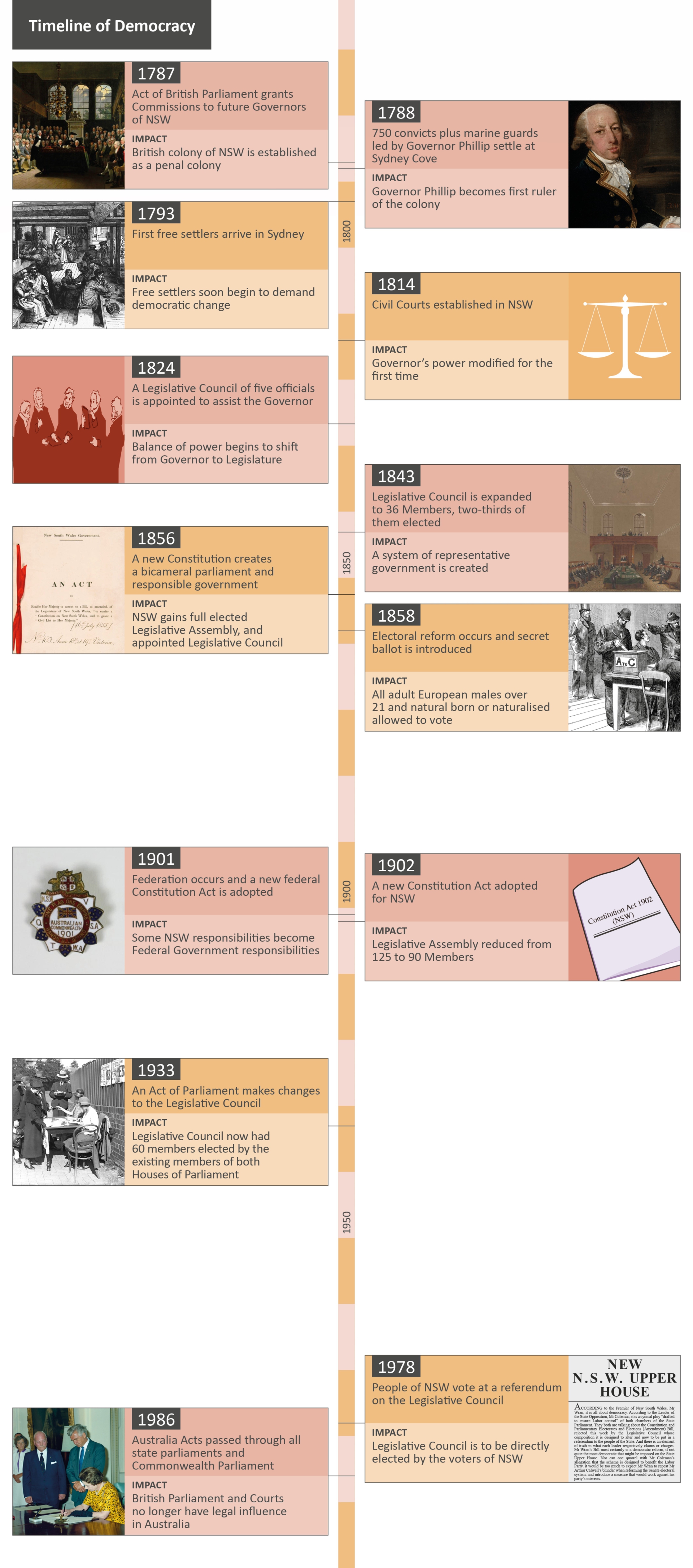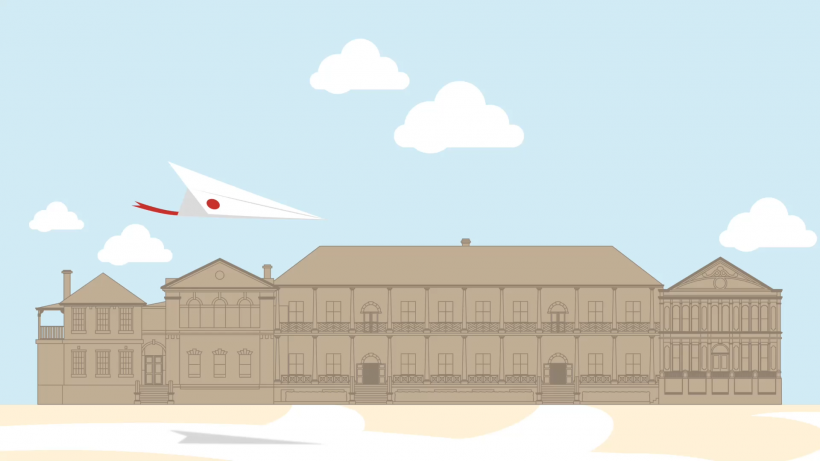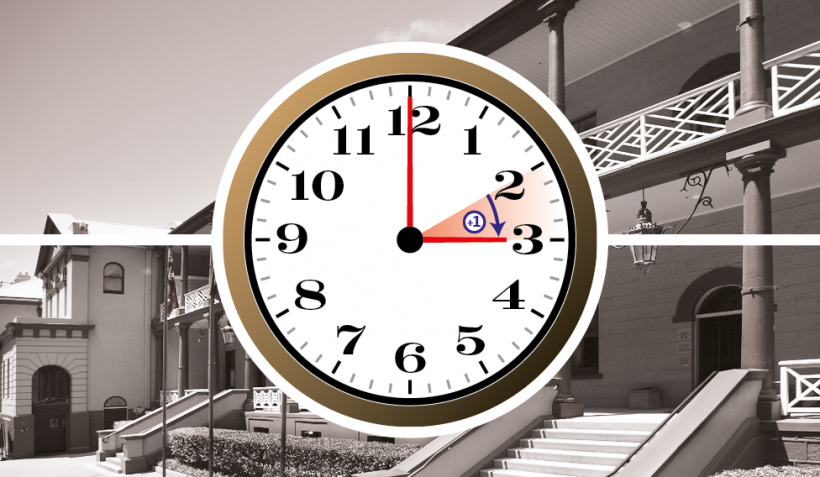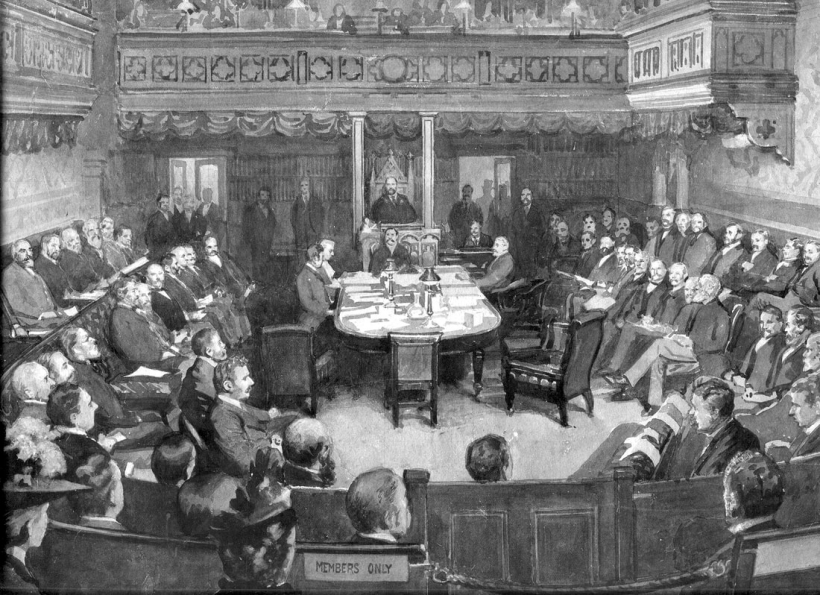Learning Outcomes
- Identify aspects of the British and USA systems of government that form part of Australia’s system.
- Identify events leading to the establishment of democratic principles in Australia’s system of government.
Syllabus Links
AUSTRALIA AS A NATION
Key figures and events that led to Australia’s Federation, including British and American influences on Australia’s system of law and government (ACHHK113)
- identify the influences of Britain and the USA on Australian democracy
- sequence key figures and events and explain their significance in the development of Australian democracy, eg Sir Henry Parkes, Edmund Barton, Louisa Lawson, Vida Goldstein
Democracy and the NSW Colony
See below for further explanations on each step.

Image Credits
The House of Commons, 1793–1794, Karl Anton Hickel (1745–1798) National Portrait Gallery, London
Married couples’ accommodation in steerage, by unknown artist, taken from the Illustrated London News, 13 April 1844.
Captain Arthur Phillip, [1786] / painted by Francis Wheatley, Mitchell Library, State Library of New South Wales
Illustration by NSW Parliament Education Office
Illustration by NSW Parliament Education Office
First meeting of the NSW Legislative Council in Parliament House, 1843 (chamber now the Legislative Assembly) Jacob Janssen
New South Wales Constitution Act 1855 (UK), House of Lords Record Office
Polling Booth Interior, Melbourne, David Syne & Co, State Library of Victoria
Badge – Australian Commonwealth, 1901 Photographer: Marita Dyson Source: Museums Victoria
The Newcastle Sun 1933 , published by Sun Newspapers, digitised by The University of Newcastle (Australia)
Recreation by NSW Parliament Education Office
Queen Elizabeth II signs the Proclamation of the Australia Act on 2 March 1986 at Government House, Canberra, with David Reid, Secretary to the Executive Council (left) and Prime Minister Bob Hawke. Image courtesy of the National Archives of Australia. NAA: A8746, KN18/3/86/33
The Steps to Democracy
1788
The British colony of New South Wales was established in 1788 as a penal colony. The governors were given the right to rule the colony by an Act of the British Parliament of 1787. The first settlement, at Sydney, consisted of about 750 convicts and their Marine guards and officers, led by Governor Arthur Phillip. As the military governor of New South Wales he was the absolute ruler, the only power superior to him being the British Parliament at Westminster in England, nearly 20,000 kilometres and 8 months away by sea. In this autocratic society, the emerging European and American concepts of democracy and liberalism at first had no place. Before the Europeans arrived the area had been inhabited by indigenous Aboriginal peoples. The European settlers disregarded the Aboriginals’ rights to their traditional lands and most of the indigenous people of the Sydney region either died from introduced diseases, were killed by the new arrivals or were forced to leave the area.
1793
The first free settlers arrived, five single men and two families. Gradually as the number of free settlers and merchants grew, along with the number of native born people and convicts who had served their time and were now free citizens, the people of the colony began to demand democratic change.
1814
Each successive Governor had almost absolute power until 1814 when Civil Courts were established and the Governor’s powers were modified for the first time. Governor Macquarie, the last Governor to hold almost absolute authority, clashed severely with the Judges of the Supreme Court who criticised some of his actions.
1824
In 1824 a Legislative Council of 5 officials was appointed to assist the Governor. This was the beginning of the Legislature. Over time the balance of power gradually shifted from Governor to the Legislature.
1843
In 1843 the Legislative Council was expanded to 36 Members, two thirds of whom were elected and one third appointed. This was the beginning of a system of “Representative Government”. At the time however, very few people were allowed to vote. It wasn’t until 1858 that the right to vote was extended to almost all adult European males and the new secret ballot was introduced at the same time. But it was not until the early twentieth century that women and, much later, all Aboriginal people, gained the right to vote.
1856
In 1856, a new Constitution for NSW created a bicameral responsible government system with a fully elected Lower House (the Legislative Assembly) and an appointed Upper House (the Legislative Council).
1901
At Federation in 1901, some of the old functions of the New South Wales Parliament, such as defence and postal services, became Federal responsibilities.
How was the Constitution Written?
Learn about the Constitutional Conventions and the lead up to federation on our dedicated topic page.
1902
A new NSW Constitution Act of 1902 reduced the members in the Legislative Assembly from 125 to 90.
1933
In 1933 an Act of Parliament halved the size of the Legislative Council to 60 members who were now to be elected by both Houses of Parliament.
1978
The people of New South Wales voted at a referendum to directly elect the Legislative Council giving New South Wales a fully democratically elected parliament.
1986
The Australia Acts increased Australia’s independence from Britain. The British Parliament or Courts no longer had a legal influence in Australia. New South Wales is now a monarchy whose Queen is the same as that of Britain and the Governor represents the Queen in the State.





